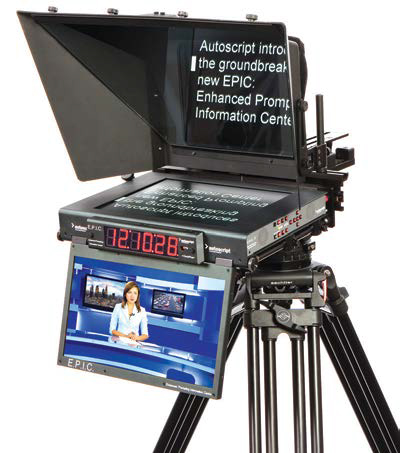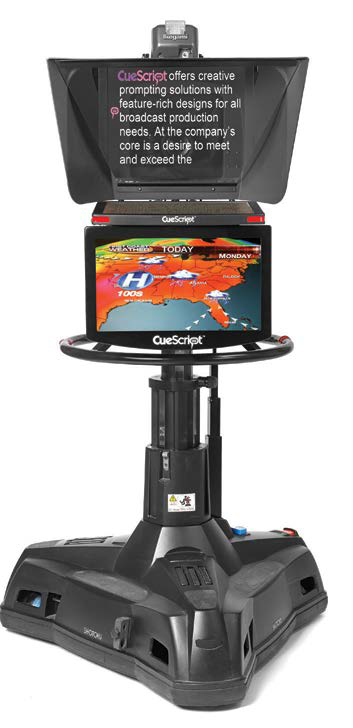Prompters Adapt to Changing Technologies

Autoscript Epic
SEATTLE—There have been so many technology changes that stations and studios and field production crews have had to implement over the past decade, that the comparatively simple teleprompter may seem like it’s doing OK. The talent reads them day after day, after all.
But according to JT Meidl, president of Mirror Image in Oshkosh, Wis., there are obvious signs when stations should replace prompters. “If you’ve still got the big, heavy CRT hanging off the front of the camera, then it’s time to change,” he said. CRTs wear out and it’s hard to find any replacements, other than on the used market where they’re probably already close to worn out.
A new style of prompter that Mirror Image has developed is its Pan/Tilt Series LCD prompter, designed for Sony or Panasonic PTZ self-contained robotic cameras. “The camera fits inside the teleprompter hood assembly, and it’s able to pan side to side and up and down, within certain limits of course,” he said. They’ve also been working with Ross on prompters for that company’s line of full-size robotic pan and tilt robotic cameras.
FADING FLAT SCREENS
According to Michael Accardi, president of Cuescript in Fairfield, Conn., not only do CRT prompters need to be replaced, but many of the older flat screen prompters aren’t delivering what they once were. “They actually do wear out,” he said. “And you don’t realize it because it’s gradual, but most of the teleprompters out there are probably 50 percent as bright as they used to be, and it makes it much harder for the talent to read.”
He noted it’s not just the prompter screens that need replacement, but “the old style mounting equipment that’s out there, it doesn’t do justice to what people need to do a prompter job today.” This is especially true when mounted on a robotic pan and tilt head, where users don’t want a lot of play in the prompter assembly fighting the very precise robotic movements.
“TV stations like that because it looks better, they can move faster,” Accardi said. “They’ve had robotics that can do a certain move, but they had to go slower because the prompter was not able to keep up. It’s [also] much better for their servos.”
Get the TV Tech Newsletter
The professional video industry's #1 source for news, trends and product and tech information. Sign up below.
Accardi said his customers aren’t afraid to spend for his highest end prompters. “People want to buy once, they want somebody to stand behind it, they don’t want any of the aggravations,” he said. A variety of inputs is also a must. “We’re composite and VGA, but we also have the HD-SDI capability, so they can input any signal they want.”
UPGRADE PATH

CueScript’s CSM Monitor with 19-inch Talent Monitor
Ray Blumenthal, vice president of Broadcast Sales for Tiffen, parent company of the Listec teleprompter brand, said his company designed its prompters to be gradually upgraded. “I’m a big believer in either retrofit or future-proofed, so when something new happens, you could upgrade it,” he said.
Blumenthal agrees with Accardi on the need to replace fading displays. “Even flat displays, the very early ones, are coming to the end of their lives,” he said. “The new ones today have displays that are so much brighter—that’s the major upgrade people are making to their prompters today.”
One example of Listec’s upgrade path is on video inputs. “If you buy a teleprompter from us today, and you’re just using composite video—which 95 percent of the people are doing at the moment—that’s fine,” Blumenthal said. “And then down the road they decide they want to turn the whole studio digital, we can update it to digital, and you don’t have to buy a whole new display. It’s a board, some connectors, and we can install it or they can install it if they’re qualified.”
Listec’s next level is its Ethernet prompter. “The advantage there is that one cable carries video and power, so you no longer have to run a separate power cable to the prompter,” he said. That was not an issue with full-sized studio cameras, “but a lot of people are using smaller ENG type cameras in their studios, and unless they buy the big buildups, they have to run a separate AC supply to the prompter,” Blumenthal said.
LIGHTEN UP
Robin Brown, Vitec’s product manager for its Autocue and Autoscript prompters, says prompters are being replaced because adjusting their size and weight is part of the trend to reduce the mass of the camera package and support. “The cameras are just getting smaller and smaller,” he said. “You no longer need the enormous heavy tripod, you don’t need the same lenses as before, you don’t need the same heavy support. And at the same time, you don’t need a massive prompter on the front.”
But he cautions about reducing the physical dimensions of the display and mirror. “The talent still have the same quality of vision, so you might get a smaller camera, and you might get a smaller head—because it has a lower payload—but you have to factor in that the talent themselves still have the same quality of vision,” Brown said. “If they want a 19-inch prompter, they’re going to get a 19-inch prompter regardless if they’ve got a DSLR camera on the back or a full sized camera.”
Autoscript lightens the load with its one-piece Epic, a prompter monitor and talent monitor in one unit. “It has a single power source and the combined weight of [Epic] is less than they would have if they currently had a large talent monitor, which was mounted separately,” Brown said. This allows the studio to reduce the head and pedestal size, which further lightens overall weight.
For those using DSLRs, Autocue has introduced a DSLR-mount prompter. “Here in the U.K., we have broadcasters that are actually using the Flashcam setup, but they’re using the DSLR cameras, they’re not even using ENG cameras,” said Brown. “It mounts on 15 mils rails, so you don’t need to use any expensive or heavy system.”
